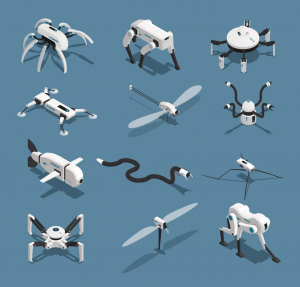Swarm Robotics
The rapid advancement of technology has opened up new aspect for engineers to design and implement innovative solutions for real-world problems. Robotics is one such field that has gained tremendous drive in recent years. It is a unique blend of mechanical engineering, electrical engineering, and computer science that focuses on the development of robots that can perform a different range of tasks. In this blog, we will discuss a unique topic in robotics that engineers can explore to create innovative solutions.

Swarm robotics is an emerging field of robotics that concentrate on the study of the behavior of large groups of simple robots, which work together to achieve complex tasks. The inspiration of the robotics is taken from the behavior of social insects such as ants, bees, and termites, which work together to achieve common goals.
It has a wide range of applications, including search and rescue operations, environmental monitoring, exploration of unknown territories, and even military operations. One of the key advantages of it is, its scalability, as the behavior of a large group of robots can be controlled by simple algorithms that are executed by each individual robot.
One of the key challenges in swarm robotics is achieving coordination and cooperation among the robots. This is typically done using simple rules that each individual robot follows, which can lead to emergent behavior at the group level. For example, ants use pheromone trails to communicate with each other and find food sources, while bees use a waggle dance to communicate the location of flowers to other bees in the hive.
Swarm robotics has already shown promising results in a number of applications. For example, in search and rescue operations, it can be used to search for survivors in a disaster area, while in environmental monitoring, it can be used to monitor pollution levels in a body of water.
There is a lots of benefits like, It offers a cost-effective and efficient way of accomplishing tasks that would be difficult or impossible for a single robot to perform. For instance, a swarm of robots could be used to explore a hazardous environment, such as a nuclear reactor, without risking human lives. It also has applications in agriculture, where robots can be used to tend crops or harvest fruits and vegetables.
One of the most exciting areas of research in swarm robotics is the development of algorithms that enable the robots to self-organize and adapt to changing conditions. These algorithms are designed to enable the robots to learn from their experiences and modify their behavior accordingly. For instance, if a robot in the swarm detects an obstacle, it can communicate this information to other robots in the swarm, enabling them to adapt their behavior and avoid the obstacle.
Another area of research is the development of robots that can work in harsh environments. For instance, robots could be used to explore the deep ocean or the surface of other planets. In these environments, the robots would need to be able to operate autonomously, without any human intervention. It also has applications in the field of transportation. For instance, a swarm of self-driving cars could be used to provide a more efficient and cost-effective transportation system. The cars could communicate with each other to optimize their routes and avoid traffic congestion.
It is divided into two categories: homogeneous and heterogeneous.
Homogeneous Swarm
It is refers to a group of robots that are all identical in terms of their hardware, software and functionalities. In homogeneous swarm robotics, each robot in the group has the same capabilities and is programmed to perform the same task or set of tasks. This approach simplifies the coordination and control of the swarm, as the behavior of the group can be controlled by simple algorithms that are executed by each individual robot. It is particularly suitable for tasks that require large numbers of robots working together to achieve a common goal, such as exploration, surveillance, and search and rescue operations. Examples of the systems include robot swarms used for environmental monitoring, precision agriculture, and automated warehouse logistics.

Heterogeneous Swarm

Heterogeneous swarm robotics refers to a group of robots that have different capabilities, functionalities, or physical characteristics. Unlike homogeneous one, where all the robots in the swarm are identical, in heterogeneous, each robot is designed to perform a different task or set of tasks. This approach enables the swarm to tackle more complex tasks that require different types of robots with complementary capabilities. Heterogeneous requires more sophisticated algorithms for coordination and control than homogeneous. Examples of heterogeneous swarm robotics systems include robot teams used for disaster response, where the swarm can consist of aerial drones for reconnaissance, ground robots for search and rescue, and underwater robots for monitoring water levels and inspecting damaged structures. Another example is precision agriculture, where a swarm of robots with different sensing and actuation capabilities can work together to optimize crop yield and minimize environmental impact.
Conclusion
In conclusion, It is a unique and exciting field of robotics that offers engineers a range of opportunities to create innovative solutions, it is a rapidly growing field with a wide range of potential opportunities. The ability of a large group of relatively simple robots to work together to achieve complex tasks is a powerful concept that has the potential to revolutionize many industries. As research in swarm robotics continues to advance, we can see even more exciting developments in the future.

